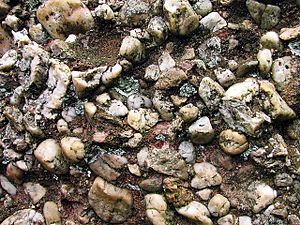Puddingstone facts for kids
Puddingstone is a special kind of rock that looks a bit like a dessert! It's made from lots of small pebbles stuck together. Imagine a bunch of tiny stones, like those you might find on a beach, all glued into one big, strong rock.
Contents
What is Puddingstone?
Puddingstone is a type of sedimentary rock. This means it forms from pieces of other rocks or minerals that settle down and get pressed together over a long time. It gets its name because it often looks like a plum pudding, with the pebbles acting like the "plums" in the "pudding" (the main rock material).
How Puddingstone Forms
This unique rock forms when pebbles, often from places like a shingle beach or a riverbed, get cemented together. This "glue" is usually a mineral called silica. Silica is a very common mineral, and it can dissolve in water. When this water dries up or changes, the silica can come out of the water and act like a natural cement, sticking the pebbles together.
What's Inside Puddingstone?
The pebbles inside puddingstone are usually made of flint. Flint is a very hard type of silica. The "glue" or matrix that holds these flint pebbles together is also made of silica. Because both the pebbles and the cement are made of silica, the whole rock becomes incredibly hard and strong.
Uses of Puddingstone
Because puddingstone is so hard and resistant to wear, people have found many uses for it over time.
- Grindstones: Its rough and strong surface makes it excellent for grindstones, which are used to sharpen tools or grind grains into flour.
- Building Material: It's also used as a strong and durable material for building structures.
- Historical Use: In some areas, like the Wye valley towards Monmouth, puddingstone was even 'mined' and shaped into millstones because of its abrasive (wearing down) qualities.



